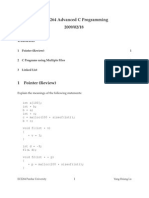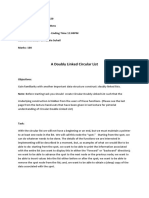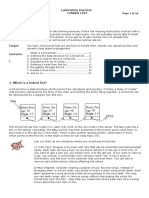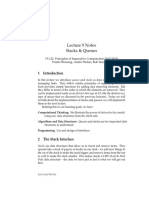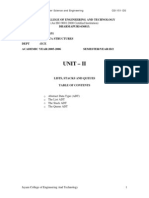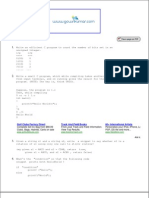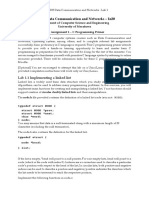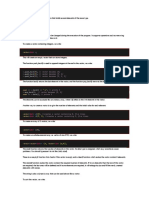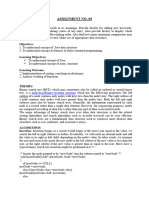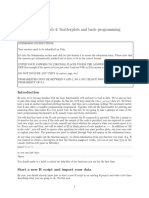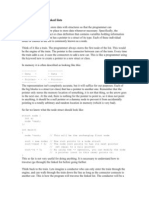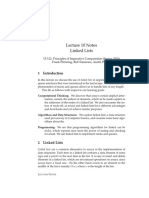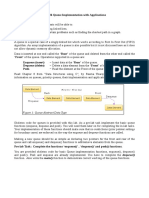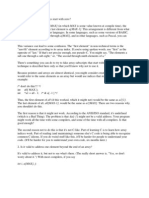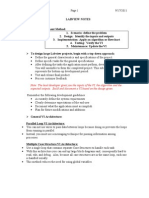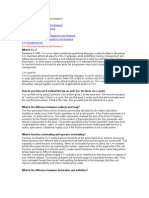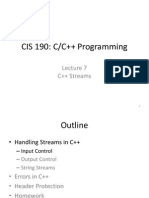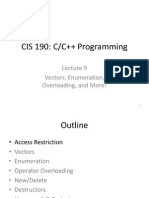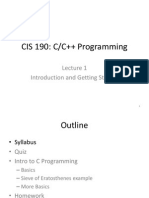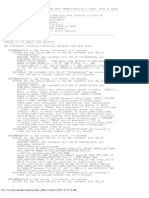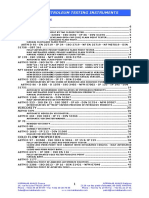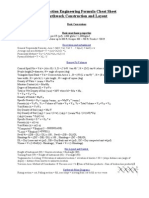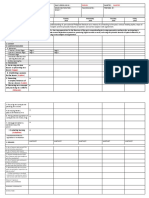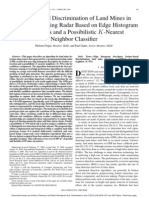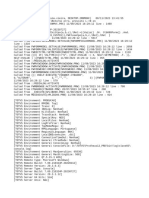Bonus Lab PDF
Bonus Lab PDF
Uploaded by
Samuel YipCopyright:
Available Formats
Bonus Lab PDF
Bonus Lab PDF
Uploaded by
Samuel YipOriginal Description:
Original Title
Copyright
Available Formats
Share this document
Did you find this document useful?
Is this content inappropriate?
Copyright:
Available Formats
Bonus Lab PDF
Bonus Lab PDF
Uploaded by
Samuel YipCopyright:
Available Formats
http://www.comp.nus.edu.
sg/~cs1010e/labs/Lab6/
for Week 13, Wednesday, 10th November 2010
Back to index page
This is a bonus lab. This lab is outside of examinable curriculum for CS1010e. While it is an achievement to be able to complete this lab, do
not worry if you are unable to solve the questions.
If you have any questions, you may post your queries in the IVLE forum of your respective lecture group.
Instructions
1. There is only one task.
2. Submit all tasks to CodeCrunch. You are given 20 submissions for each task.
3. You may need to refer to the C online reference here.
There is no deadline.
1 of 12
11/9/2010 7:20 AM
http://www.comp.nus.edu.sg/~cs1010e/labs/Lab6/
In this task you are given an input containing n lines, each is a string of length n where 1 <= n <= 20. This input corresponds to a maze, with
'#' being the walls and '.' being traversable spaces. Your task is to find the path, given a start coordinate and the end coordinate. The maze
traveler may only move 4 directions: up, down, left and right.
We use the "keep your left hand on the wall" method. The algorithm to complete solve the maze problem is given as follows:
while destination is not reached,
if you can turn left, then turn left,
otherwise if you can go forward, then stay put
otherwise if you can turn right, then turn right
otherwise turn back.
move forward for one step
The first line of a input is a single number n, which indicates the size of the grid.
The next n lines contains a string of length n each. Each character in the string is either '.' or '#', where '#' represent the walls and '.'
represent traversable spaces.
The next line contains 4 numbers. The first two numbers are the row and column numbers of the start position. The next two numbers are the
row and column numbers of the end position.
Your output should the original grid with the '+' character indicating the path taken.
2 of 12
11/9/2010 7:20 AM
http://www.comp.nus.edu.sg/~cs1010e/labs/Lab6/
Sample run using interactive input (user's input shown in blue; output shown in bold purple. Note the space after every
number including the last number.
10
##########
#.####...#
#....#.#.#
####.#.#.#
#......#.#
#.##.#.#.#
#....#.#.#
######.#.#
######....
##########
1 1 8 9
##########
#+####+++#
#++++#+#+#
####+#+#+#
#...+++#+#
#.##.#.#+#
#....#.#+#
######.#+#
######..++
##########
Sample run 2:
10
##########
#.####...#
#....#.#.#
####.#.#.#
#......#.#
#.##.#.#.#
3 of 12
11/9/2010 7:20 AM
http://www.comp.nus.edu.sg/~cs1010e/labs/Lab6/
#....#.#.#
#.####.#.#
#........#
##########
1 1 7 1
##########
#+####+++#
#++++#+#+#
####+#+#+#
#...+++#+#
#.##.#.#+#
#....#.#+#
#+####.#+#
#++++++++#
##########
Sample run 3:
10
##########
#.####...#
#....#.#.#
####.#.#.#
#......#.#
#.##.#.#.#
#....#.#.#
######.#.#
######...#
##########
8 8 7 6
##########
#.####...#
#....#.#.#
####.#.#.#
#......#.#
#.##.#.#.#
#....#.#.#
4 of 12
11/9/2010 7:20 AM
http://www.comp.nus.edu.sg/~cs1010e/labs/Lab6/
######+#.#
######+++#
##########
Sample run 4:
10
##########
#.####...#
#....#.#.#
####.#.#.#
#......#.#
#.##.#.#.#
#....#.#.#
######.#.#
######...#
##########
8 8 6 1
##########
#.####...#
#....#.#.#
####.#.#.#
#...+++#.#
#.##+#+#.#
#++++#+#.#
######+#.#
######+++#
##########
Sample run 5:
10
##########
#.####...#
#....#.#.#
####.#.#.#
#......#.#
5 of 12
11/9/2010 7:20 AM
http://www.comp.nus.edu.sg/~cs1010e/labs/Lab6/
#.##.#.#.#
#....#.#.#
######.#.#
######...#
##########
8 8 1 1
##########
#+####...#
#++++#.#.#
####+#.#.#
#++++++#.#
#+##+#+#.#
#++++#+#.#
######+#.#
######+++#
##########
You should write your code in the file Maze.c
Submit your program through CodeCrunch.
Warning: This section introduces new concepts such as dynamic memory allocation and pointer to pointer to struct. The program requires a
deep understanding of pointers and is a challenge to even A+ students. If you do not want your brain to explode in a spectacular manner,
leave this page and go to here. In your lecturer's time (which is not too long ago), LinkedList was taught in the last lecture of the CS1010E
equivalent module.
In computer science, a linked list is a data structure that consists of a sequence of data records such that in each record there is a field that
contains a reference (i.e., a link) to the next record in the sequence.
6 of 12
11/9/2010 7:20 AM
http://www.comp.nus.edu.sg/~cs1010e/labs/Lab6/
Linked lists are among the simplest and most common data structures; they provide an easy implementation for several important abstract
data structures, including stacks, queues, associative arrays, and symbolic expressions.
The principal benefit of a linked list over a conventional array is that the order of the linked items may be different from the order that the data
items are stored in memory or on disk. For that reason, linked lists allow insertion and removal of nodes at any point in the list, with a
constant number of operations. This is not true in an array, where we have to perform a shift on all items to the right if we were to insert an
item at any point in the array.
For this task, you will be implementing a simple Linked List data structure to store a sequence of numbers. You will be implementing only a
single function which is listed below:
insert (num, i) : Insert an the number num at position i.
(Optional) You may wish to also implement this function:
delete (i) : deletes the item at position i.
8 of the test cases will test a series of insert operations. 2 of the test cases will test a series of insert AND delete operations. If you did not
implement the optional part of this question, you will fail 2 test cases, so don't be surprised.
A working sample code is given to you. It will require extensive modifications before you can use it to to complete your task. You should code
modularly (implement the functions insert and delete), otherwise it would defeat the purpose of attempting this exercise.
We will begin to explain the details of this problem. The section below is a summary of what you need to know.
7 of 12
11/9/2010 7:20 AM
http://www.comp.nus.edu.sg/~cs1010e/labs/Lab6/
List Nodes
Before we start, we need to understand the concept of a Linked List. A Linked List is a chain of Nodes. Each node is connected to a single
node (as seen in the diagram above) in a chain. In this task, a Node need only store two information: its payload (which is the value it is
storing) and a pointer to the next node in the list. For example in the diagram above, the leftmost node is storing the value 12, and have a
pointer pointing to the node containing the value 99.
Naturally we would use a struct to represent a node. We do this with the struct definition below:
struct ListNode
{
struct ListNode *next;
int value;
};
For example to construct the list in the diagram above, we can simply call the following statements:
struct ListNode a, b, c;
c.value = 37;
c.next = NULL;
//This means that c does not have a next element
b.value = 99;
b.next = &c;
//This means that the next element of b is a pointer to c
a.value = 12;
a.next = &b;
//This means that the next element of a is a pointer to b
The head of the list is at the ListNode a. We can see that a has a pointer to b, b has a pointer to c and c does not point to anything.
Printing out the Nodes
When printing out a String, we can simply iterate through all the characters until we reach the null character and halt.
This is similar when we try to print out the contents of a List. We iterate until we see that the next pointer is not pointing to anything.
void printList(struct ListNode *curr)
{
while(curr != NULL)
8 of 12
11/9/2010 7:20 AM
http://www.comp.nus.edu.sg/~cs1010e/labs/Lab6/
{
printf(?d ? curr->value);
curr = curr->next;
}
printf(\n?;
}
Dynamic Memory Allocation
Unlike an array where the memory space is allocated during compilation and not runtime, the memory used by a Linked List increases
dynamically during runtime when items are added into the list. As such we need to perform dynamic memory allocation by calling the
function malloc whenever we need to add a new item to the list. The function malloc returns a pointer to the memory allocated.
The function malloc requires a parameter - which is the size in bytes to allocate the memory. We can easily obtain the size required by our
ListNode struct by using the function sizeof as follows:
sizeof(struct ListNode)
//Try doing the following: printf("%d %d", sizeof(int), sizeof(double));
Therefore to request the OS to allocate a memory location to our ListNode, we do the following:
malloc(sizeof(struct ListNode));
Malloc returns a void pointer to the memory allocated. To avoid compilation warnings, we should cast it to the appropriate type. Naturally we
should assign this memory space to a pointer so that we can access it later on.
struct ListNode *node = (struct ListNode *)malloc(sizeof(struct ListNode));
Now that we have introduced the basic concepts, we can start working on our program!
Adding an item
To help you out, we demonstrate how to add an item to the beginning of the list. The idea is that we shift the current head node to the
RIGHT. To do this, we set the new item that we are going to add as the new head node, and set the next element of this new head node to
be pointing to the old head element.
int main()
{
struct ListNode *head = NULL, *temp;
9 of 12
11/9/2010 7:20 AM
http://www.comp.nus.edu.sg/~cs1010e/labs/Lab6/
int n;
do
{
scanf(?d? &n);
if(n > 0)
{
temp = malloc(sizeof(struct ListNode);
temp->value = n;
if(head == NULL)
head = temp;
else
{
temp->next = head;
head = temp;
}
}
} while(n > 0);
printList(head);
}
For clarity, it is recommended that you look at the slides to understand how this piece of code works. Naturally, we want to have modular
code. We rewrite the code above to obtain the following:
int main()
{
struct ListNode *head = NULL, *temp;
int n;
do
{
scanf(?d? &n);
if(n > 0)
{
addHead(&head);
}
} while(n > 0);
printList(head);
10 of 12
11/9/2010 7:20 AM
http://www.comp.nus.edu.sg/~cs1010e/labs/Lab6/
}
void addHead(struct ListNode **head)
{
struct ListNode *curr = malloc(sizeof(struct ListNode));
curr->value = num;
if(*head == NULL)
*head = curr;
else
{
curr->next = *head;
*head = curr;
}
}
You may notice that the fuction addHead takes a pointer to a pointer as an argument. Why do we need to do that? This is because, with
every insertion, the head node will change. If we call the function addHead with just the pointer to the struct as an argument, any changes to
the value of the pointer itself will not apply to the head variable in the main function!
Input and Output
The input contains n lines. Each line consists of a String command, followed by the parameters required by the command. There are three
possible commands
insert
delete
halt
If the command is insert, there will be two integers num and i following the command. This means to insert the number num at position i. You
may assume that the position is always valid (if there are only two items in the list, valid positions would be 0, 1 and 2).
If the command is delete, there will be one integer i following the command. This means to delete the number at position i. Again you may
assume that the position specified is always valid.
If the command is halt, you should stop asking for user input and print the list.
11 of 12
11/9/2010 7:20 AM
http://www.comp.nus.edu.sg/~cs1010e/labs/Lab6/
Sample run using interactive input (user's input shown in blue; output shown in bold purple).
insert 1 0
insert 2 0
insert 3 0
halt
3 2 1
Sample run 2:
insert 1 0
insert 2 1
insert 3 2
halt
1 2 3
Sample run 3:
insert 1 0
insert 2 0
insert 3 0
insert 4 3
halt
3 2 1 4
Download the skeleton file LinkedList.c here. You will need to make significant modifications to this code to solve this task.
Submit your program through CodeCrunch.
12 of 12
11/9/2010 7:20 AM
You might also like
- 2610 Sample FinalDocument9 pages2610 Sample FinalKolomMolokNo ratings yet
- Process Hazard Analysis: (Failure Mode Effect Analysis)Document41 pagesProcess Hazard Analysis: (Failure Mode Effect Analysis)Nate JamesNo ratings yet
- Hong Kong University of Science and Technology COMP104: Programming Fundamentals and MethodologyDocument23 pagesHong Kong University of Science and Technology COMP104: Programming Fundamentals and MethodologyMertcan BaharNo ratings yet
- ECE 264 Advanced C Programming 2009/02/18: 1 Pointer (Review) 1Document9 pagesECE 264 Advanced C Programming 2009/02/18: 1 Pointer (Review) 1truongvinhlan19895148No ratings yet
- Answer Key Set a CT2Document16 pagesAnswer Key Set a CT2Aaniya JainNo ratings yet
- A Doubly Linked Circular ListDocument7 pagesA Doubly Linked Circular Listkhawar abbasiNo ratings yet
- CARLOM Laboratory Exercise 3 Linked ListDocument21 pagesCARLOM Laboratory Exercise 3 Linked ListEDRICK PARASNo ratings yet
- Experiment 6: University of Engineering and Technology, TaxilaDocument4 pagesExperiment 6: University of Engineering and Technology, TaxilaAfras AhmadNo ratings yet
- COL106 Assignment 2Document5 pagesCOL106 Assignment 2Vamsikrishna YadavNo ratings yet
- How Would You Check If A Binary Tree Is BalancedDocument11 pagesHow Would You Check If A Binary Tree Is BalancedZubair AlamNo ratings yet
- Cs 2208 Data Structures Lab 0 0 3 2 (Repaired)Document33 pagesCs 2208 Data Structures Lab 0 0 3 2 (Repaired)sumiyamini08No ratings yet
- Ds 1Document8 pagesDs 1michaelcoNo ratings yet
- NptelDocument27 pagesNptelSoumodip ChakrabortyNo ratings yet
- Week 1Document12 pagesWeek 1a1extrusion2021No ratings yet
- Lecture 9 Notes Stacks & QueuesDocument12 pagesLecture 9 Notes Stacks & QueuesGursimran PannuNo ratings yet
- Lab3 - Linked List - SolutionDocument10 pagesLab3 - Linked List - Solutiondemro channelNo ratings yet
- Chapter 4 ALGODocument11 pagesChapter 4 ALGOethiopia1212 ethoNo ratings yet
- 8 PuzzleDocument18 pages8 PuzzlemanimellaankammaraoNo ratings yet
- Study MidDocument4 pagesStudy MidJosh CohenNo ratings yet
- Doubly Linked List OperationDocument17 pagesDoubly Linked List Operationsiddhant kudesiaNo ratings yet
- Unit - Ii: (An ISO 9001:2000 Certified Institution)Document29 pagesUnit - Ii: (An ISO 9001:2000 Certified Institution)jayaprabamcaNo ratings yet
- Mubeena Rajini C++Document120 pagesMubeena Rajini C++RajiniNo ratings yet
- SQL Functions For Data Analysis Tasks PDFDocument16 pagesSQL Functions For Data Analysis Tasks PDFsgoranksNo ratings yet
- DS - Linked List Using C++Document18 pagesDS - Linked List Using C++JANARDHANA RAO ALAPATINo ratings yet
- Assignment: 7: Due: Language Level: Allowed Recursion: Files To Submit: Warmup Exercises: Practise ExercisesDocument6 pagesAssignment: 7: Due: Language Level: Allowed Recursion: Files To Submit: Warmup Exercises: Practise ExercisesYanling LinNo ratings yet
- Programming QuestionsDocument4 pagesProgramming QuestionsshafirahmNo ratings yet
- DSA - Linked List PDFDocument36 pagesDSA - Linked List PDFSneha AgarwalNo ratings yet
- Golf Clubs Factory Direct Track and Field Books 60+ International ArtistsDocument16 pagesGolf Clubs Factory Direct Track and Field Books 60+ International ArtistssamrajcseNo ratings yet
- Lab 03Document8 pagesLab 03Shakeel AhmadNo ratings yet
- CS2040 Tutorial3 AnsDocument7 pagesCS2040 Tutorial3 Ansjoanna tayNo ratings yet
- Sep 11 Certs D ReportDocument18 pagesSep 11 Certs D ReportJessica TiffanyNo ratings yet
- Lab 1Document9 pagesLab 1Risinu WijesingheNo ratings yet
- Algo 3Document8 pagesAlgo 3Kudikala RishikeshNo ratings yet
- Skip ListDocument23 pagesSkip Listtanyagoswami11No ratings yet
- C++ Linked List Data StructureDocument5 pagesC++ Linked List Data StructureIshaan kataraNo ratings yet
- Dynamic Memory Allocation and Dynamic Structures: Full ProgramDocument6 pagesDynamic Memory Allocation and Dynamic Structures: Full ProgramAntônio Eduardo CarvalhoNo ratings yet
- DSAL Ass5 WriteupDocument10 pagesDSAL Ass5 WriteupGaurav ShindeNo ratings yet
- Write A C Program To (I.e, Free Up Its Nodes)Document23 pagesWrite A C Program To (I.e, Free Up Its Nodes)Umesh NarayananNo ratings yet
- Chapter 4 - Linked ListsDocument48 pagesChapter 4 - Linked ListsBethelhem AshenafiNo ratings yet
- Chapter 3 - Linked ListsDocument47 pagesChapter 3 - Linked Listsmishamoamanuel574No ratings yet
- STA1007S Lab 4: Scatterplots and Basic Programming: "Hist"Document9 pagesSTA1007S Lab 4: Scatterplots and Basic Programming: "Hist"mlunguNo ratings yet
- Assignment3-NIT CALICUT DSADocument11 pagesAssignment3-NIT CALICUT DSAJ AnanthakrishnanNo ratings yet
- Linked ListDocument3 pagesLinked ListAshish KumarNo ratings yet
- DS AssignmnetDocument6 pagesDS AssignmnetHanan AslamNo ratings yet
- 10 LinkedlistDocument17 pages10 Linkedlistrishitibest123No ratings yet
- Figure 1: Queue Abstract Data TypeDocument3 pagesFigure 1: Queue Abstract Data TypeSouban JavedNo ratings yet
- Python Notes by Jobhunter TeamDocument255 pagesPython Notes by Jobhunter TeamChinamayi ChinmayiNo ratings yet
- H25 MidtermPractice PDFDocument5 pagesH25 MidtermPractice PDFrahulmnnit_csNo ratings yet
- Int I, A (MAX), JDocument11 pagesInt I, A (MAX), JKiran GunasegaranNo ratings yet
- Stack QuesDocument6 pagesStack QuesRaffi SkNo ratings yet
- Linked List Data StructureDocument27 pagesLinked List Data StructureashfaquexkhanNo ratings yet
- DSA Assignment ShreyaDocument29 pagesDSA Assignment Shreyasajwanisanskar3No ratings yet
- SYSC 2006 Mock Final PDFDocument5 pagesSYSC 2006 Mock Final PDFJames MaxNo ratings yet
- Flow Chart For Product of First N Natural Numbers: Syllabus/Lectures/Same/First Grade/programming 1 PDFDocument7 pagesFlow Chart For Product of First N Natural Numbers: Syllabus/Lectures/Same/First Grade/programming 1 PDFraghunadhaswamyNo ratings yet
- 2011 Fall2017 Final NO SolutionsDocument12 pages2011 Fall2017 Final NO SolutionsVictor BuicaNo ratings yet
- Labview NotebookDocument40 pagesLabview Notebooktvu0244689No ratings yet
- CSP Lab Manual 9Document11 pagesCSP Lab Manual 9ẄâQâŗÂlïNo ratings yet
- C Interview Questions and AnswersDocument63 pagesC Interview Questions and AnswerskakashokNo ratings yet
- 9842 DSA Exp3Document7 pages9842 DSA Exp3Alan Michael RajNo ratings yet
- ADVANCED DATA STRUCTURES FOR ALGORITHMS: Mastering Complex Data Structures for Algorithmic Problem-Solving (2024)From EverandADVANCED DATA STRUCTURES FOR ALGORITHMS: Mastering Complex Data Structures for Algorithmic Problem-Solving (2024)No ratings yet
- Ocm Attachments May16-1Document252 pagesOcm Attachments May16-1Samuel YipNo ratings yet
- CIS 190: C/C++ ProgrammingDocument88 pagesCIS 190: C/C++ ProgrammingSamuel YipNo ratings yet
- CIS 190: C/C++ ProgrammingDocument65 pagesCIS 190: C/C++ ProgrammingSamuel YipNo ratings yet
- Assurance - Iron Curtain V RolloverDocument5 pagesAssurance - Iron Curtain V RolloverSamuel YipNo ratings yet
- Inventory Request: SK Jewellery Pte LTDDocument1 pageInventory Request: SK Jewellery Pte LTDSamuel YipNo ratings yet
- K35 Touchpanel ManualDocument15 pagesK35 Touchpanel ManualSamuel YipNo ratings yet
- CIS 190: C/C++ ProgrammingDocument99 pagesCIS 190: C/C++ ProgrammingSamuel YipNo ratings yet
- CIS 190: C/C++ Programming: Vectors, Enumeration, Overloading, and More!Document95 pagesCIS 190: C/C++ Programming: Vectors, Enumeration, Overloading, and More!Samuel YipNo ratings yet
- CIS 190: C/C++ Programming: Memory Management in CDocument79 pagesCIS 190: C/C++ Programming: Memory Management in CSamuel YipNo ratings yet
- CIS 190: C/C++ Programming: Introduction and Getting StartedDocument56 pagesCIS 190: C/C++ Programming: Introduction and Getting StartedSamuel YipNo ratings yet
- CIS 190: C/C++ Programming: Assorted Topics (And More On Pointers)Document140 pagesCIS 190: C/C++ Programming: Assorted Topics (And More On Pointers)Samuel YipNo ratings yet
- CIS 190: C/C++ Programming: Not So BasicsDocument127 pagesCIS 190: C/C++ Programming: Not So BasicsSamuel YipNo ratings yet
- Assurity Trusted Solutions Pte LTDDocument2 pagesAssurity Trusted Solutions Pte LTDSamuel YipNo ratings yet
- Korean Level 2 (Seoul National University Language Education Institute)Document184 pagesKorean Level 2 (Seoul National University Language Education Institute)Samuel YipNo ratings yet
- End User ComputingDocument3 pagesEnd User ComputingSamuel YipNo ratings yet
- Forecasting I I (Forecasting With ARMA Models)Document19 pagesForecasting I I (Forecasting With ARMA Models)Samuel YipNo ratings yet
- OracleDocument4 pagesOraclearif420_999No ratings yet
- Petroleum Testing InstrumentsDocument118 pagesPetroleum Testing InstrumentsFebrian IsharyadiNo ratings yet
- Construction Engineering Formula Cheat SheetDocument4 pagesConstruction Engineering Formula Cheat SheetCresanelle PoloNo ratings yet
- FSU - Learning Theories and Strategies GuideDocument27 pagesFSU - Learning Theories and Strategies GuideTravis Grant100% (2)
- Plant Performance TestDocument10 pagesPlant Performance TestUjang Sonjaya100% (2)
- Capacity Building For Septage Management PlanDocument86 pagesCapacity Building For Septage Management PlanAmrita BhatnagarNo ratings yet
- Hotlist IdsDocument879 pagesHotlist Idsnithish41100% (1)
- Pit QuarryDocument100 pagesPit Quarrybeto pagoadaNo ratings yet
- Citizen A16VI Machine SpecificationsDocument2 pagesCitizen A16VI Machine SpecificationscmganklNo ratings yet
- FinalFIT Outline 1Document6 pagesFinalFIT Outline 1Naseer KhanNo ratings yet
- Module 2 - Session 1Document18 pagesModule 2 - Session 1Elimer EspinaNo ratings yet
- Sprinkler IrrigationDocument33 pagesSprinkler Irrigationkallady100% (5)
- S-18-13306 - DR1162 - M1 Crossover Duct 1 (42t) & M2 Crossover Duct 2 (56t) - BDocument2 pagesS-18-13306 - DR1162 - M1 Crossover Duct 1 (42t) & M2 Crossover Duct 2 (56t) - Bpuspa ningrumNo ratings yet
- Datasheet: Control PanelDocument2 pagesDatasheet: Control PanelGerman O.No ratings yet
- Irf640n PDFDocument12 pagesIrf640n PDFLeonel Antonio100% (1)
- USGBC Names William Amann As LEED FellowDocument2 pagesUSGBC Names William Amann As LEED FellowM&E EngineersNo ratings yet
- Daily Lesson Log In: Quarter: Grade /Section/Time: Grade 7 - Teaching Dates: Prepared byDocument2 pagesDaily Lesson Log In: Quarter: Grade /Section/Time: Grade 7 - Teaching Dates: Prepared byReymartNo ratings yet
- Seminar Report Liquid LensDocument27 pagesSeminar Report Liquid LensTanmoy Tatwadarshi50% (2)
- My CVDocument1 pageMy CVsetiawan wawanNo ratings yet
- Interview Java QuestionsDocument4 pagesInterview Java Questionsguntur123No ratings yet
- Owner'S Manual: FG110 Mini-TillerDocument24 pagesOwner'S Manual: FG110 Mini-Tillerpazz0No ratings yet
- XPXMP-18 ManualDocument45 pagesXPXMP-18 Manualtulio enrique leon ayalaNo ratings yet
- Mono DocumentationDocument259 pagesMono DocumentationPino AffeNo ratings yet
- Universite Batna 2 Mathéma3ques Et Informa3que Département: InformatiqueDocument2 pagesUniversite Batna 2 Mathéma3ques Et Informa3que Département: Informatiqueanwar apNo ratings yet
- Introduction To DrivetrainsDocument10 pagesIntroduction To DrivetrainsThiago PereiraNo ratings yet
- Special FoldersDocument3 pagesSpecial FoldersChad SharpNo ratings yet
- EhdDocument15 pagesEhdPratul YadavNo ratings yet
- An Introduction To Reading ComprehensionDocument4 pagesAn Introduction To Reading ComprehensionGeorge Pinca0% (1)
- Error LOG P12Document150 pagesError LOG P12matheus felipeNo ratings yet



